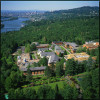main content Water Storage
Be Aware
An ample supply of clean water is a top priority in an emergency. Store one gallon per person per day for at least 72 hours. Make sure you know how to access the water in your hot water tank if needed. If supplies run low, never ration water. Drink the amount you need today, and try to find more for tomorrow.
If a disaster catches you without enough water, follow these steps to access the water in your hot water tank:
- Find your incoming water valve. Shut it off to avoid possibly contaminated water from entering your hot water tank.
- Turn off the gas or electricity to the tank.
- Turn on a hot water faucet in the house.
- Collect water as needed from the tap at the bottom of the hot water heater.
Prepare
How to Store Water:
Bottled drinking water should be stored out of direct sunlight, away from chemicals (which could permeate the container) and in an area that is not likely to freeze. Commercially bottled water can be stored for up to 1 year and tap water kept in safe containers can be stored up to 6 months before replacing. You can buy approved water jugs or use well-washed, plastic soda bottles. Avoid empty bleach, detergent and milk jugs. After 6 months discard stored tap water, thoroughly wash containers and refill with fresh tap water. If water is stored too long or its purity is in question, follow procedures for purifying.
Helpful hint: Bottled water will taste better if you put oxygen back into it by pouring the water back and forth between two clean containers. This will also improve the taste of stored water.
Respond
How to Purify Water:
You should purify all water of uncertain purity before using it for drinking, food preparation or hygiene. Two easy methods include:
Boiling: Bring water to a rolling boil for 3 to 5 minutes. Let the water cool before drinking.
or
Disinfection: You can use household liquid bleach to purify water. Use only regular household liquid bleach that contains 5.25 percent sodium hypochlorite. Do not use scented bleaches, color safe bleaches or bleaches with added cleaners.
Add 16 drops of bleach per gallon of water, stir and let stand for 30 minutes. If the water does not have a slight bleach odor, repeat the dosage and let stand another 15 minutes.
Note: Iodine or water treatment products often sold in camping stores which do not contain household liquid bleach with 5.25 percent sodium hypochlorite as the only active ingredient, are not recommended and should not be used.
Distillation: The two methods described above are recommended for the general public. If however, you have a medical condition that requires you to use only distilled or sterile water, now is the time to learn how to distill water in case you need to during a disaster. Contact your physician to verify your water requirements and contact your local Red Cross for written instructions on how to distill water.
Campus Safety is located in Campus Safety on the Undergraduate Campus.
MSC: 107
email safety@lclark.edu
voice 503-768-7855
fax 503-768-7195
Emergency 503-768-7777
Alternate Phone 503-593-5457
Director Jeremy Ranft
Campus Safety
Lewis & Clark
615 S. Palatine Hill Road
Portland OR 97219
